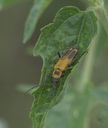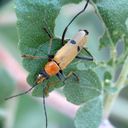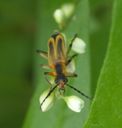Chauliognathus
Chauliognathus
Classification
- Phylum: Arthropoda
- Subphylum: Hexapoda
- Class: Insecta
- Order: Coleoptera
- Suborder: Polyphaga
- Superfamily: Elateroidea
- Family: Cantharidae
- Subfamily: Chauliognathinae
- Tribe: Chauliognathini
- Genus: Chauliognathus
Pronunciation
How to pronounce Chauliognathus: /kaʊ.liː.oʊɡˈneɪ.θəs/
These audio files are automatically generated. While they are not always 100% accurate, they are a good starting point.
Images






Summary
Chauliognathus is a genus of soldier beetles within the family Cantharidae, known for their striking coloration and role as both pollinators and insect predators. They thrive in various habitats, particularly those rich in flowers, and undergo a series of larval instars before emerging as adults.
Physical Characteristics
Adults have almost rectangular bodies. They can be red and black or orange and black. The elytra (first pair of wings) are softer than the elytra of most beetles, which contributes to their common name 'leatherwings.'
Identification Tips
Key to species can be found in specialized literature. Look for coloration patterns and body shape.
Habitat
Frequented areas include flowers such as sunflowers, goldenrod, and coneflowers in open habitats. Larvae are more common in the ground or among debris.
Distribution
Widespread in North America but much more diverse in the southern regions. Some species, like C. pennsylvanicus and C. marginatus, are found widely in the eastern U.S. and extend into Canada, while others are mostly restricted to the southwestern U.S.
Diet
Adults feed on pollen and nectar; larvae are predators feeding on eggs or larvae of other insects.
Life Cycle
Adults are active in summer and fall and overwinter as larvae underground. There can be as many as 10 instars during larval development.
Reproduction
Adult beetles mate on flowers, following which the females lay eggs in suitable habitats for larvae.
Ecosystem Role
Adults likely play a role as pollinators, while larvae help control populations of other insect eggs and larvae.
Collecting Methods
- Netting adults from flowers
- Hand collecting larvae from the ground
Preservation Methods
- Pinning
- Ethanol preservation
Misconceptions
The name 'soldier beetle' may suggest aggression, but they are generally harmless and are important for ecological balance as pollinators and predators.
Tags
- Chauliognathus
- soldier beetles
- Cantharidae
- pollinators
- predatory larvae